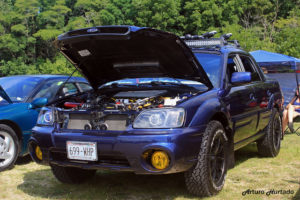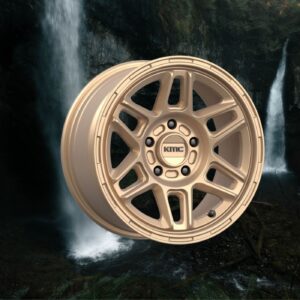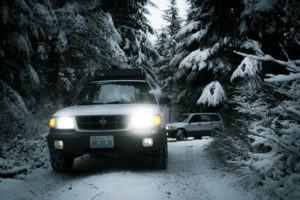6 Tips To Reliably Modify Your Subaru For Offroading
Everything you need to Dependably take your Subaru on adventures
By Ben Boxer
Last updated on March 17th, 2024
Some of the most fun I’ve had has been in my lifted Subaru. I’ve seen some of the most amazing natural wonders and enjoyed mind boggling scenic back roads in it. I’ve even taken it on brutal 4×4 trails that most Subarus would never dream of exploring. However, my build is not ideal for daily driving. It’s a second car for me and was purchased strictly with the intent of being pushed to its limits and beyond.
But what about those of us who just want to take our cars off-road without ruining their drivability and completely destroying the car?
You may want to have an “adventure-mobile” without doing irreversible mods, or reducing your cars overall reliability. There are some simple mods that can be added to any Subaru to make it more capable and ready for off-road use. This helpful guide will explain some of the easiest mods that everyone should add to their list of must-haves that won’t destroy your car’s dependability.
Aggressive Tires (Don't Go Overboard)
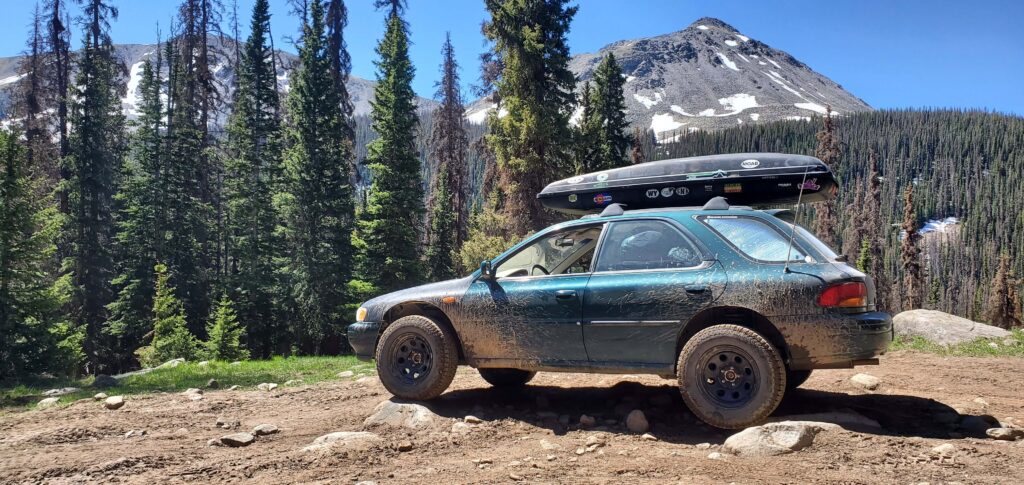
The first and most easy mod to add to your Subaru is a good set of All-Terrain tires. But if you’re wanting to maintain reliability, don’t go too big with your tire upgrade. You may be able to find a good set of Yokohama Geolandars or Toyo Open Country’s in your stock size, or even a tad bigger than the factory size.
For some tire sizes you may not even need to install a lift kit. In fact, choosing to stay close to the stock tire option will help you retain most of your Subaru’s wheel horsepower. Sizing up TOO much can add a lot of unsprung weight and make your car feel gutless on the trails.
Unlike traditional 4×4 platforms, Subarus do not have low gears like Jeeps or 4Runners, or the ability to easily re-gear for larger tires. While we can upsize a bit, putting an oversized tire on Subarus that’s too big can make the car almost no fun and even cause drivetrain issues like transmission overheating.
We do recommend sizing down wheels as much as possible though. I purchased my Forester with 17 inch wheels on it. The first thing I did was size down to a 15 inch wheel to allow for much beefier tires. In fact, you can get more sidewall without even increasing overall diameter. If you want to get a more capable tire without trimming your fenders or adding a lift kit, simply sizing down wheels and upsizing tire sidewall can be super helpful for your build.
Here are some of the benefits of a smaller rim and a taller sidewall:
- Ability to air down for the trails without popping or de-beading a tire
- More comfortable, quiet ride
- Additional flex creates less chance of puncturing a tire
The main thing to keep in mind when sizing down is the limitation of your brake components. For example, the Ascent has a very large brake caliper that would not allow for a 15 inch wheel. Instead, a 17 or 18 inch rally style wheel (check out would be a better option on that vehicle (many brands, such as Method and Black Rhino, make “rally” wheels that have barrels designed to clear larger brake kits.
A good rule of thumb that I’ve found when selecting an off-road tire for a Subaru, is to not add more than 10 lbs. to each wheel/tire. 10 lbs. is the absolute limit of what I will put on a Subie. Better yet, if you can stay under 5 added pounds, it makes the car much easier to daily drive. It can be hard to do this, but if you upgrade to a performance wheel it can be done pretty easily.
On the 2015 Crosstrek, the stock wheels and non-aggressive factory tires weigh right around 47 lbs when mounted together. However, you can get better performance by switching to the common upgraded wheel/tire combo of the Black Rhino Rumble paired with the General Grabber AT/X tire in 215/75R15. It weighs only 49 lbs when mounted! In fact, this upgrade adds 1 inch of tire diameter and a much more durable tread and sidewall while only adding 2 lbs.
It might seem insignificant, but saving rotational mass at the wheels and tires can be very beneficial to the performance of your car. Don’t forget, we’re usually going to be loading our Subies up with rooftop tents, a spare tire, camping gear, recovery devices, air compressors, passengers, and whatever else we want to take with us out into the forest. That all adds up and will chew away at your horsepower quickly. If you have a turbocharged Subaru it can take time for the turbo to spool up and deliver extra power. But even when that power is provided, it’s still limited by our transmissions. This is why I suggest being conservative with your tire selection when upgrading to something more aggressive.
If you’d like to upgrade to an offroad tire, we’ve compiled a list of some of the best tires for lifted Subarus to help you choose the right ones for your car.
Lift Kits
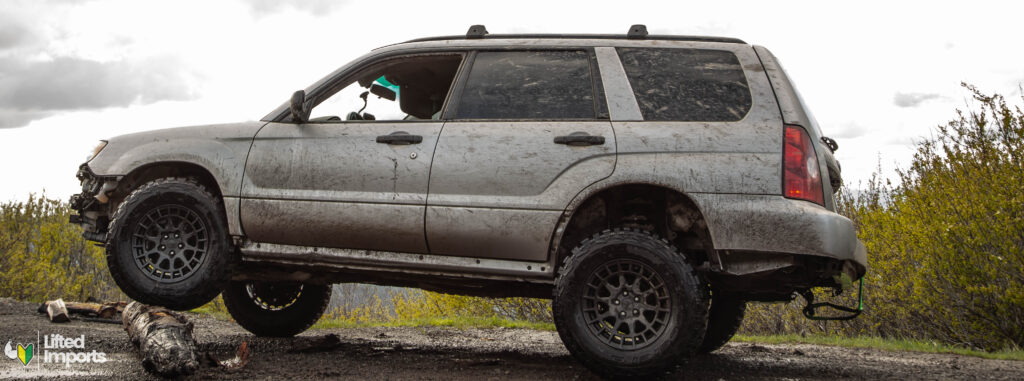
For some, a lift kit may not be necessary at all. But for those of us who want to fit a larger tire and really enjoy the security of having a few extra inches of ground clearance, a lift is a must.
There are now a wide range of options available for lifting a Subaru. In the past, it was an almost taboo undertaking that a select few had dared involve themselves in. Luckily though, it’s now much easier to find exactly what you need and the newer kits involve almost no permanent modifications to the vehicle.
Most lift kits can be installed in about a day if you are mechanically inclined and have no rust on your car. But professional install can usually be had for under $600 depending on where you live and the type of lift kit you have.
There are two main types of lifts for Subarus: lift spring and strut spacers.
Lift springs are taller and usually stiffer than the stock springs that came on your vehicle. You’ll have to swap out the factory springs with the new kit. They are really good for anyone who plans to load extra gear into the car. They also help stabilize the car’s handling ability even with a higher center of gravity after lifting. The main complaint with a stiffer spring is that they can be a little more bumpy on harsh roads, but they handle much better and resist sagging.
Strut spacers are much easier to install and do not create an uncomfortable off-road experience. They can be easily bolted to the top of your struts without too much hassle. The only downside is that they don’t offer any change in the spring rate. This may be a “con” if you are planning to really load up the car with a bunch of gear.
In terms of reliability, doing either of these lifts is a great idea. However, for the average enthusiast I typically don’t suggest going much over 2 inches. Anything more than that and you are going to have to do a lot of extra work that offers almost no benefit. Remember, the main purpose of a lift is not only to offer ground clearance, but to fit bigger tires. Many of the most capable off-road rigs don’t have much ground clearance at the diffs. But they do have extremely large tires that allow them to navigate over difficult objects. On a Subaru, a 2 inch lift allows you to fit a tire that is essentially at the limit of what’s realistic for your Subarus drivetrain.
We laid out the details on some of the Subaru lift kits available for you in this helpful guide, and they’re actually more affordable than you might think- Best Subaru Lift Kits
Skid Plates
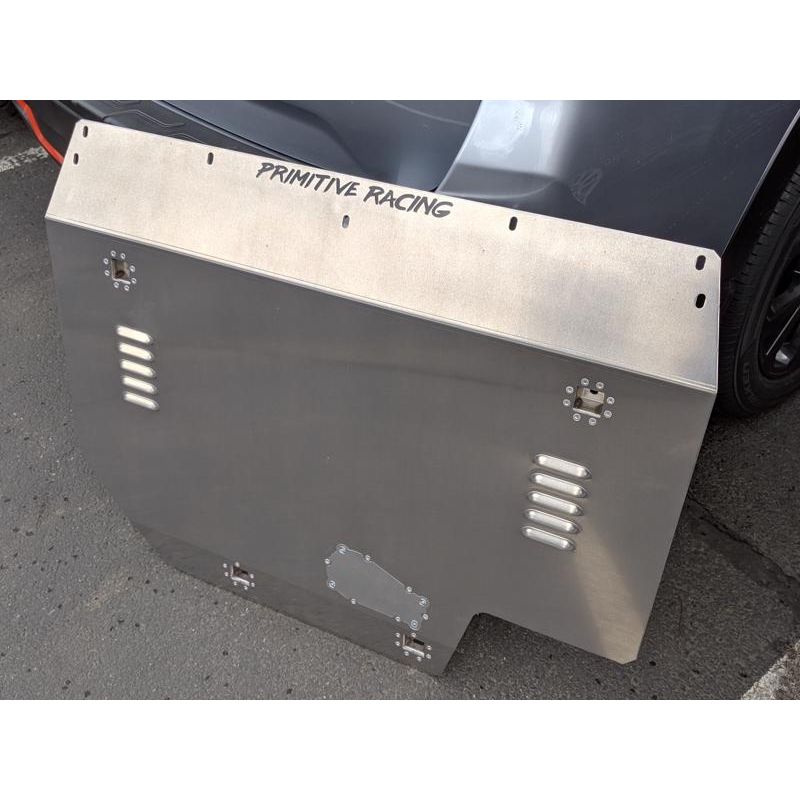
If you are planning to take your Subaru anywhere off of the beaten path, skid plates should be your first mod. They are usually affordable and very easy to install.
My Primitive Racing skid plates have been bashed against rocks, slammed into ruts, and even banged into concrete barriers in the snow. While they’re likely not meant to be an invitation to abuse your car, they can give you the confidence to try certain trails that would otherwise be too nerve racking in a subie.
The skid plates on my Forester have saved my transmission and oil pan from serious damage. The initial $400 investment has not only saved me over $2000 worth of repair costs, but also given me peace of mind when I’m out in the woods enjoying my car.
My Forester build has a front plate, automatic transmission pan plate, and a rear diff plate. I typically recommend running a front skid plate, and if you don’t have a manual transmission, a CVT or auto tranny pan skid plate at the very least. If you can afford a rear diff skid, that’s also not a bad idea.
If you have an auto transmission of any sort, your pan is full of delicate solenoids that will leave you dead in the water if they’re crushed. Imagine being 50 miles from the nearest paved road and having absolutely no way of fixing your car. A $150 pan plate can eliminate that dreaded situation.
If you’re not sure which skid plates are best for you, check out this roundup of the four best skid plates available for Subarus.
Reliable Battery System
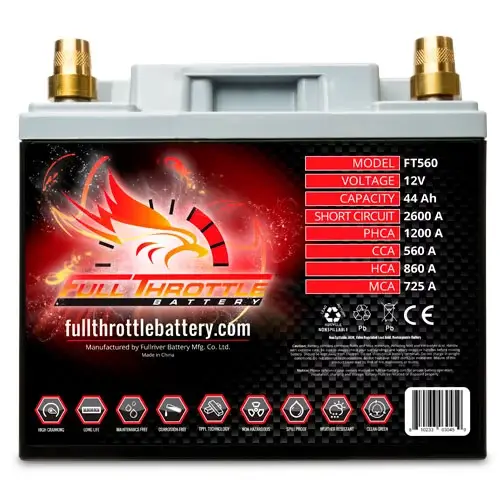
I had no idea how important a reliable power source was until I began speaking with the folks over at MeLe Design Firm in Portland (MeLe produces the best battery mounting solutions for Subarus, hands down.) I had been looking into a more powerful battery option to help keep up with my trail abuse and my increased power demands as I began adding accessories to my Subaru. Mitch at MeLe answered a lot of the questions I had about switching to an upgraded AGM battery and helped me realize that I was in fact making the right decision to upgrade.
The main benefits of switching to a performance AGM or Lithium battery:
- Can be ordered in a smaller size that allows for a neater engine bay
- Lithium batteries reduce weight (a huge factor in off-roading in a Subaru)
- More reliable power delivery to the ignition system
- Last much longer than traditional lead acid stock batteries
- Saves people large amounts of money in the long run
- Exponentially less likely to leave you stranded in the wilderness
If you are taking your vehicle off-road, you NEED to make sure you have a power source that won’t degrade from vibration and shock. Over time the cells in a traditional battery can break apart from vibration and stop functioning. AGM and Lithium batteries are also much more resistant to cold weather. People have literally been stranded for days due to a battery that failed. The extra $100 could be the difference between making it home and a life & death situation.
I ultimately chose to go with a Full Throttle AGM battery in my Forester to handle the off-road vibrations, and the extra power demand of light bars and a winch. MeLe offers a kit that replaces the factory tie down and fits the Full Throttle battery perfectly. I installed it with rivnuts and have never felt more confident in my battery’s reliability. I like the Full Throttle batteries but there are some great performance batteries for Subarus that you can check out.
NOTE: One big reason I chose to go with a MeLe mounting kit is the fact that they act as an insulator. Most aftermarket mounting options don’t provide any insulation. In the winter this allows heat to escape from the battery and allows engine heat to soak it in the summer. This ultimately degrades the internal components and causes premature failure. Many of the other “performance” mounting kits that I considered were simple frame designs that didn’t enclose the battery at all. They also didn’t have options for a big enough battery to reliably power a winch and a healthy amount of auxiliary lighting and were made out of steel. The MeLe kits are made with high quality aluminum that won’t rust and they have multiple sizes that can accommodate more powerful battery units.
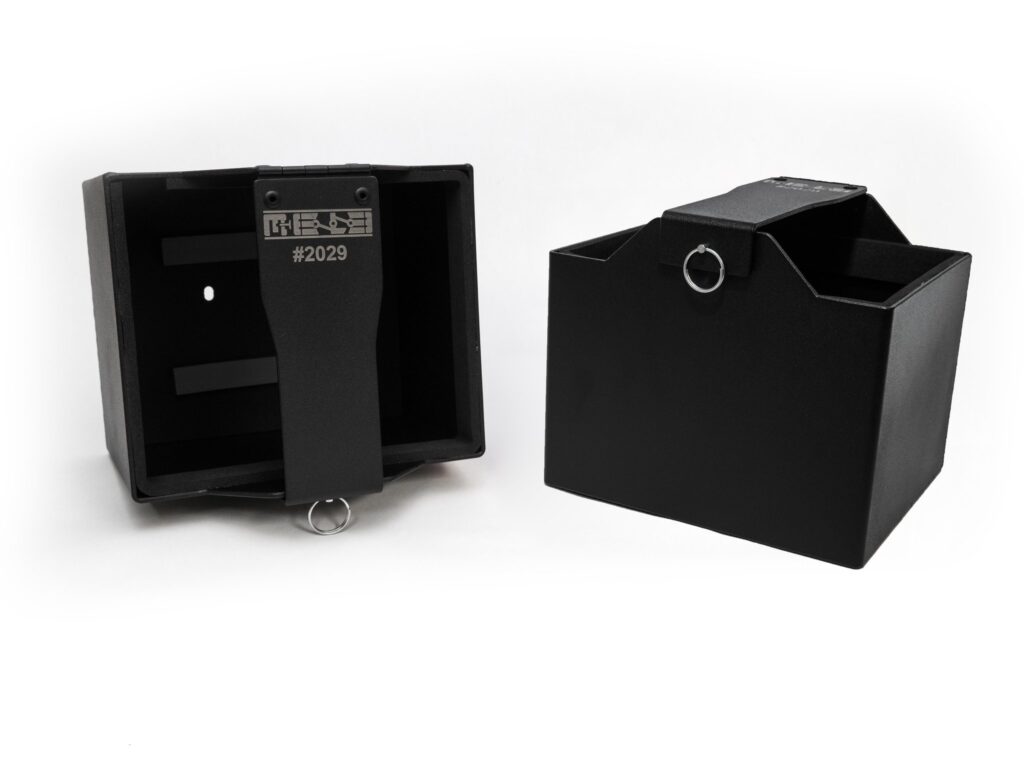
Although upgrading to a performance battery is somewhat of a costly experience, it actually saves money in the long run. The average car battery will last around 3 years. But a performance battery from a reputable company, such as Odyssey, Full Throttle, or Anti-Gravity will last closer to 6-8 years depending on driving habits.
I waited about 6 years into my off-roading hobby before finally upgrading. But every time I went out and bounced my car around on trails, I was taking a huge risk. Don’t be stupid like I was. Make the investment before you need it stranded in the middle of nowhere.
Recovery Gear
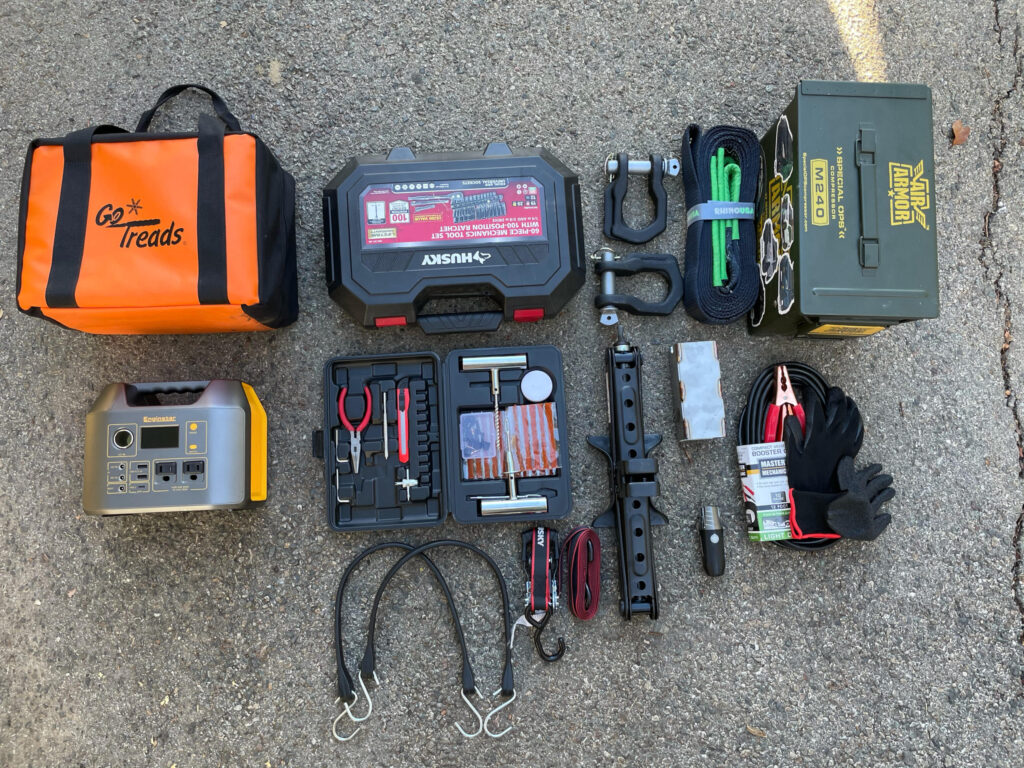
Your car isn’t very reliable if it’s stuck in the forest. I’ve been there and done that. I’ve hiked miles out to find help. I’ve waited in the dark for a bigger rig to help with recovery. It’s part of the game, but definitely avoidable.
My bare minimum recovery kit includes the following gear:
- A small shovel
- Bottle jack (easily one of the most cost effective tools)
- Recovery boards
- Recovery strap
- D ring shackles
This kit weighs very little, can be almost entirely stored in the spare tire compartment, and doesn’t have to cost a lot. However, with a little strategy and ingenuity you can get out of just about any situation with these tools. It may take some work and a bit of time. But you’ll be able to safely recover your vehicle from mud, snow, sand, or being high centered.
It’s also good to be able to help out others that you may encounter on the trail. It’s a good feeling to save someone the expense of having a tow company come out and perform a costly recovery. You may even make a friend.
Regular Fluid Changes
I’m hesitant to even put this on my list because it’s so elementary. But the importance of performing basic maintenance on your Subaru increases substantially when you introduce the stress of off-road driving. Engine oil should be done using high quality fluids and good filters. I personally change my oil no later than the 3k mark. But this might vary with newer vehicles that have 7-10k mile intervals. I would typically prefer to err on the side of caution and go no longer than 6-7k if I’ve been pushing the car hard. I use Amsoil or Royal Purple products and follow the manufacturer’s oil weight recommendation.
I use an app in my phone to track and make sure the transmission fluid, front diff gear oil, and rear diff get checked on regularly. I never exceed the interval recommended by Subaru and I routinely change these fluids prior to the factory recommendation.
Bad fluids can degrade the mechanical parts of your car quicker than just about any other factor. Make sure you’re keeping up on them and not letting your car down. Hopefully, it will do the same for you.
In addition to keeping up on changes, it’s a good idea to also store a bottle of motor oil, transmission fluid, brake fluid, and gear oil in your vehicle during long trips.
It's Okay To Modify According To Your Comfort Level
I wrote this article with the intention of helping the everyday adventurer get out and see the world without destroying their Subaru’s reliability. Most folks don’t want to chop their fenders, start ripping off panels or cut bumpers.
But if that’s you, we’re actually in the same boat. We love pushing these cars to their physical limits. We have trail damage up and down the body of our cars and every wheel has boulder damage. However, we understand that’s not everyone’s cup of tea. Some folks just want to casually be able to navigate back roads and find new areas to explore without ruining a $30,000 vehicle.
However, it’s okay to see how far you can go with the Subaru platform. If you are an adventurous person who likes testing the limits, it’s okay to install bigger tires
Check out these other helpful articles for your Subaru:

